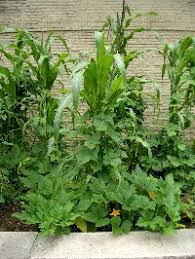My interest in the Indians of Texas also led me to learn about the Caddo who were farmers. This made me curious about blue corn meal, the kind of corn meal preferred by most Indian Nations.
As I browsed the grocery store for blue corn meal, I found flours made from both amaranth and spelt. All of these grains have been used by people for thousands of years. I brought home all three kinds for experimentation. I will describe the history and provide recipes that take advantage of the unique tastes of these three grains that have contributed so much to human history.

Corn probably first originated about 7000 years ago. Controversy exists about the exact origin, but some scientists believe it originated as teosinte, a grass quite different from corn. Other scientists believe that it originated from a relative of teosinte, but I will leave those details to the scientists! Archaeological evidence from Mexico shows that around 5000 years ago, people in Oaxaca were domesticating something that was intermediate between teosinte and modern corn.
John Doebley and his associates at the University of Wisconsin investigate the genetic origins of corn and the relationship between corn and teosinte. You might want to find more details about their work on their website at http://teosinte.wisc.edu. The picture below, taken by by John Doebley is from that site.

Another interesting site is http://farma.qfb.umich.mx/etnomaii.htm.
At this site, scientists from Universidad Michoacana describe how leaching of heavy metals into the water around Mexican volcanoes could have caused teosinte mutations. This in turn could have been a factor in the transformation from teosinte to corn.
There are four major lineages of corn, and by the time Columbus found the New World, Indians were already growing all four types. Some of the oldest corn is actually popcorn!
Corn was an all purpose crop during its early domestication. People ate the corn, fed it to their domesticated animals, and ground it to save for later needs. They also used the cobs and husks to make mats and household tools.
The Maya had some of the earliest myths about the origin of maize, the crop that was so important to their existence.
By going to http://www.mythinglinks.org/ip~maize.html you can see detailed information about corn myths. I will briefly summarize the Mayan and Hopi corn myths here. Also, I found information about corn and Mayan agriculture that you might be interested in at http://www.authenticmaya.com/maya_agriculture.htm.
No comments:
Post a Comment